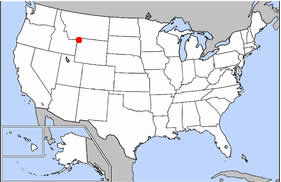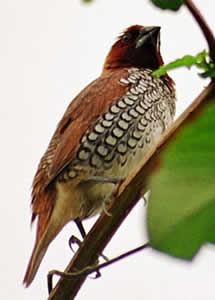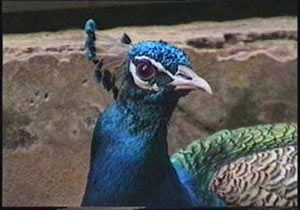Adventure
 'I believe any trip in search of wildlife can be coupled with physical activity and elements of cultural diversity to form a thrilling opportunity ' 'I believe any trip in search of wildlife can be coupled with physical activity and elements of cultural diversity to form a thrilling opportunity '
John H.Eickert |
This adventure does not take place in India. I want to share my favorite adventure here where I live in the central Rocky Mountains of North America. The adventure trip takes place in Yellowstone National Park. Yellowstone is a large
expanse of nearly wild land encompassing vast scenic vistas, mystical thermal areas, and sometimes-abundant wildlife. Almost three million people journey to Yellowstone every year, each seeking their own adventure, fulfilling their needs. While much of Yellowstone
is accessible via paved road, some areas are still remote. There are hundreds of miles of back country trail. Though it took 28 years of planning and walking I am proud to say I have walked all of these back country trails involving 52 separate trips.
 My favorite time is fall and my favorite adventure takes place in the southeast corner of the Park, an area known as the Thorofare. It is a thru hike, not an out and back or loop. The length of the trail is perhaps 60 miles. If it
is hot, it can seem much longer and that is why I prefer fall. In the fall, the mornings are crisp, the aspen tree foliage takes on a dull yellow color, and fewer people visit the Park. It is possible to spend days in the Thorofare area this time of year without
seeing another person. My favorite time is fall and my favorite adventure takes place in the southeast corner of the Park, an area known as the Thorofare. It is a thru hike, not an out and back or loop. The length of the trail is perhaps 60 miles. If it
is hot, it can seem much longer and that is why I prefer fall. In the fall, the mornings are crisp, the aspen tree foliage takes on a dull yellow color, and fewer people visit the Park. It is possible to spend days in the Thorofare area this time of year without
seeing another person.
This adventure begins with a boat ride across Yellowstone Lake to the trail head. From there, the trail winds up a large "U" shaped valley, along the Yellowstone River, past ancient limestone bluffs, through modest forests of fir and
aspen, then over the Continental Divide at a pass named "Two Ocean." There is a creek at Two Ocean where the waters divide, one running to the Atlantic Ocean and the other to the Pacific Ocean. For me, this parting of the waters is a magical place. It pulls
me back time after time.
On this trek, I have seen grizzly bears, wolves, buffalo, mule deer, wapiti, eagles, and the North American moose. The encounters with these wild animals take place in a remote setting without any barriers. The weather can be uncertain.
There have been days where it snowed, rained, and became very hot, just in the morning!
One night Elizabeth and I were camped at Mountain Creek, deep in the Thorofare. We set up our tent, created a wonderful dinner, and then snuggled in for the night. The sounds of grunts, whistles, and shoving woke us from our sleep. Outside
our tent, in a quarter-moonlit meadow, two male wapiti were locked in combat over the right to mate with a small herd of females. Fall, in Yellowstone, is the mating season for these animals. We poked our heads out, watching this dim shadowy combat and enjoying
the sounds. That experience was wonderful and magic.
This fall, Elizabeth and I will once again take the ferry across the lake and begin the trek thru the Thorofare and over Two Ocean. I wish you could come along. Cheers.
(Note by IWC Team: Yellowstone National Park, in the U.S.A is located in Idaho, Wyoming and Montana - shown as a red dot in the map)
Visit http://www.numbum.net or call NumBum Adventurers at 406-777-2228
|
Answers To Quiz Of The Month
This month no one have given right answer. but adeeba@gmail.com, chattorajd@yahoo.com and mhassim@aus.ac.ae have given 9 right anwsers.
Right Answer toQuiz on Little Known Wildlife Sanctuaries
|
| 1.Katerniaghat Wildlife Sanctuary in Uttar Pradesh, Singhalila Wildlife Sanctuary in West Bengal and Suhelwa Sanctuary in Uttar Pradesh, have one thing in common. That is |
|
All of them border Nepal |
All are at high altitude
|
They are all tiger reserves
|
|
| 2.Tigers are believed to move between Royal Bardia National Park in Nepal and ------------------------- |
|
Corbett National Park in Uttar Pradesh |
Valmiki Tiger Reserve in Bihar |
Suhelwa Sanctuary in Uttar Pradesh
|
|
| 3.Otters and fishing cats are found in the creeks of this sanctuary situated in Andhra Pradesh |
|
Sobebarwa Sanctuary
|
Eturnagaram Wildlife Sanctuary |
Coringa Wildlife Sanctuary
|
|
| 4.High up in the mountains of Western Ghat, this park was originally established to protect the Nilgiri Tahr. |
|
Eravikulam National Park |
Chinnar Wildlife Sanctuary |
Parambikulam Wildlife Sanctuary
|
|
| 5.Around 210 bird species have been identified in this bird sanctuary spread over 25.16 sq. km in Kerala. The name is…………. |
|
Thattekad Bird Sancuary |
Peppara Wildlife Sanctuary |
Agasthya Vanam Biological Park
|
|
| 6.Parappar dam, Idukky dam and Peechi dam in the state of --------------------- have given rise to small wildlife sanctuaries around the large lakes created from once flowing rivers. |
|
| 7.65 km south east of Udaipur in Rajasthan, is this 423 sq.km sanctuary where the chousingha ( four-horned antelope can be seen. The name is………… |
|
SitaMata Sanctuary |
Darra Sanctuary |
Bhensrod sanctuary
|
|
| 8.This 578 sq.km sanctuary is the only one in India where the Indian wolf is seen breeding successfully. The name is………………. |
|
Tadoba Sanctuary |
Kumbalgarh |
Pench Tiger Reserve
|
|
| 9.In this highest national park in West Bengal, look for sightings of the rare Blood Pheasant and the Red Panda. The Park is……………. |
|
Neora Valley |
Dudhwa |
Singhalila
|
|
| 10.In this wildlife sanctuary in Uttaranchal, look for the rare Himalayan Monal and Musk Deer. The sanctuary is ………………… |
|
Valley of Flowers |
Chilla National Park |
Kedarnath Wildlife Sanctuary
|
|
Please try this month quiz onrivers/lakes originating in national parks/sanctuaries
|
Common Birds of India
By - Ragoo Rao
I have chosen the Spotted Munia bird this month because the nesting season is on and our members and site visitors could locate the birds and perhaps study the birds nesting and brood rearing behavior a little more.
 As the name suggests the sparrow sized bird which has brown upper parts and white under parts with black blotches, is a common sight in open fields and home gardens. One can hardly feel the presence of the bird unless their gentle
and low Chie...chip...chie...singing is heard. Both the sexes look alike. The distribution is throughout India except for the arid regions of Punjab and parts of Rajasthan. As the name suggests the sparrow sized bird which has brown upper parts and white under parts with black blotches, is a common sight in open fields and home gardens. One can hardly feel the presence of the bird unless their gentle
and low Chie...chip...chie...singing is heard. Both the sexes look alike. The distribution is throughout India except for the arid regions of Punjab and parts of Rajasthan.
The spotted munia chooses open country with cultivated fields. They sometimes will be groups of a few hundred birds. They fly about foraging on grass seeds and grains with disorganized grouping and undulating flying pattern. Basically
grain eaters, they also relish the winged termites. Only one or two pairs could be found in home gardens.
The nesting season is mainly from July to early October. The nest is built in small thorny trees in the fields and inside the creepers in home gardens. Often group of nests can be found in a single shrub, in open fields. The nest is
an oblong mass of dried grass blades with an entrance hole. In home gardens if one finds a munia with a blade of grass in its beaks, its a sure indication of a nest nearby. Both sexes share nest building work. Four to six or sometimes even eight eggs are laid
and both parents share all domestic chores.
The young fledglings hang around the nesting area itself for some time and then fly out to be on their own. A very sober, quiet lovable bird, the munia can be enticed into home gardens by proving a bird feeder with grains like
Bajra and other small millets. A water trough in the garden invites a lot of other birds also.
|
Did You Know ?
By - Shivani Thakur
As we celebrate of our Independence Day, our freedom reminds us of the sorry state of our national bird and national animal. Both are under Schedule1 of Wildlife Protection Act 1972. Although the disappearance of Tigers has jolted
the Ministry of Environment to set up task force, the Peacock is still getting the step-motherly treatment.
 The male Peacock (Pavo cristaus) is a swan sized bird with a fan shaped crest of feathers, a white patch under the eye and long slender neck. The male of the species is more colorful than female with a glistening blue breast and
neck and elongated feathers. The female is brownish, slightly smaller than the male and lacks the train. The Peacocks belong to the pheasant family and largely found in the Indian sub-continent -to the south and east of Indus river, in Jammu and Kashmir, east
Assam, south Mizoram and other places. The heavy peacock concentration is found in Harayana, Punjab,Rajasthan ,Delhi,Gujrat and U.P. It is believed to be a harbinger of the approaching monsoon with its elaborate courtship dance seen all over the country before
the rains. Many associate this bird with fertility and good luck. Its status as the 'vahan' of Kartikeya, son of Lord of Shiva and its role in Hindu mythology has offered its some immunity over the years. But unfortunately this is fast changing. The male Peacock (Pavo cristaus) is a swan sized bird with a fan shaped crest of feathers, a white patch under the eye and long slender neck. The male of the species is more colorful than female with a glistening blue breast and
neck and elongated feathers. The female is brownish, slightly smaller than the male and lacks the train. The Peacocks belong to the pheasant family and largely found in the Indian sub-continent -to the south and east of Indus river, in Jammu and Kashmir, east
Assam, south Mizoram and other places. The heavy peacock concentration is found in Harayana, Punjab,Rajasthan ,Delhi,Gujrat and U.P. It is believed to be a harbinger of the approaching monsoon with its elaborate courtship dance seen all over the country before
the rains. Many associate this bird with fertility and good luck. Its status as the 'vahan' of Kartikeya, son of Lord of Shiva and its role in Hindu mythology has offered its some immunity over the years. But unfortunately this is fast changing.
Today, its population under threat due to habitat destruction, poaching and contamination of food source. Ironically, until today no census has been conducted of the peacock. The sole stock taking of the peacock population was done by
WWF India in 1991. According to detailed examination conducted by Chowdhary Charan Singh of Hissar Agricultural University in Haryana, the deaths of peafowls reported in village Rampura in Mahendragarh on Dec 2 ,1999, was due to consumption of seeds treated
with pesticide 24D,a weedicide. The Earth Island Journal reported death of peacocks is due to Chlorpyriphos toxicity .The birds eat seeds which are treated with this pesticide. But the mortality was among male peacocks only who fell from trees, unable to fly.
The other cause is poaching done for their beautiful feathers and even for fat, which is erroneously believed to be useful in treatment of arthritis. Poaching is also one for white meat. While the young ones are trapped for eating, male
peacocks are killed for feathers. Although law permits collecting of moulted feathers, most of the time the case is not so. Most of peacocks are killed during mating season when it is easier to locate them as they dance in the open. It is also easier to hunt
them because they sleep in the same trees every night. The killing procedure is also barbaric where the birds are first trapped, legs broken, feathers pulled out and later on killed.
Peacocks and other birds play a crucial role in the food chain. By feeding on insects and controlling weeds, they increase the nitrogen content of the soil. Yet their effective role is being sidelined for the immense beauty they possess.
Time is not far when we Indians would no longer be proud as Peacocks.
(Photograph of peacock- Susan Sharma: Buy a VCD about the peacock byclicking here)
|
Gardening for wildlife
By- Promila Chaturvedi
With the change in season the temperature is coming down. This is the time when we have to prepare our garden for winter. In plains of our country during hot weather there is very little annual colour. Only during cold months most annuals
are grown to give colour to our gardens. For growing the annuals in one's garden you can either buy seeds and sow them or directly buy the seedlings plant them in seasonal beds, depending on the availability and size of your garden. For a small garden one
can buy seedlings, but for a big garden it is not only economical to buy seeds and grow them in seed- beds but it will also ensure variety in flowers.
How to prepare seed-bed
Seeds are sown in raised bed or in seed-pans. Soil for sowing seeds should have one part soil, one part sand and two parts of fine sifted leaf-mould. In case leaf-mould is not available well- rotted cow-dung manure can be used. Finely powdered peat mixed with
vermiculite or sphagnum moss and partite can also be used as a medium for sowing seeds.
A protected sunny spot is chosen for seed beds. A workable size of seed bed is 2.6ft.-3ft. If the soil is not good replace 1ft. soil with the above mentioned mixture in it. In good soil, dig 15in deep, break it well and make raised bed 4in above the ground
level; in this top 9in soil should have sand and leaf-mould in it. The bed should be made even. To control fungal attack, charcoal dust can also be added. It should be watered with a can having a rose (shower) attachment. After sowing, the seed should be covered
and gradually bed should be exposed to the sun. If seedlings are too close, thin them by plucking some in between for their proper growth. They can be planted in flower beds or in pots. When seedlings are 3-5in in size they can be placed in flower beds or
in pots.
The winter seedlings which are easily available and easy to grow are Phlox, Calendula, Marigold, Nasturtium, Hollyhock, Voila/pansy, Alyssum, Larkspur, Clarkia, Antirrhinum, Sweet Sultan, Sweet William, Stock, Dahlia etc. For shade Salvia and cineraria are
ideal.
|
News and Views
News……………………..
Our online chat on 18 th August was free- wheeling and democratic. Positive. Looking for solutions rather than blaming each other . IWC believes that the ideas that are generated in any discussion should be more important than the persons
who generate them. Our online chats are striving towards that.
Read the chat transcript for the month by clicking here.
http://www.indianwildlifeclub.com/chat/chat-archive.aspx?cid=28
If you cannot make it to the chat room every month, we do have a 24 hour, 31 day open forum for you to jot down your ideas - The IWC Weblog, unfortunately not seeing its potential yet, as a generator of ideas. Here is the linkhttp://www.indianwildlifeclub.com/blog/
Have you visited
http://www.wildscapes.net recently? Well, the site has got a much needed makeover and, we believe, is more user- friendly. The missing pictures are in place and a couple of new photographers added.
Our usual features are there in the ezine : a write up on the spotted munia, a passionate plea to take our national bird seriously, a short check list to prepare for winter annuals in the garden and a glimpse of trekking in the Yellow
Stone national park!
We have added a new feature on the home page called “ Film Corner” Do check it out. It is on the right hand side towards the bottom of the home page.
And Views……………………..
“In around 2040, India’s population will start declining, thus reducing pressure on land. If India is able to execute economic reforms, India’s income will rise dramatically in coming years. It is possible to envision extraordinary benefits
from biodiversity, ranging from tourism to research, in the years to come in the context of a prosperous India with a declining population. The puzzle that we face is that of saving enough species over this most-dangerous period of 2005-2040. Putting aside
1-2 percent of India’s area for this purpose appears to be a small price to pay.”
Ila Patnaik in Indian Express dated 25 Aug 2005
|